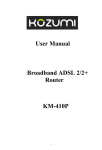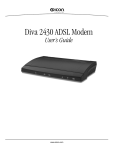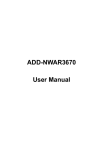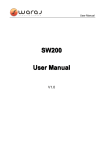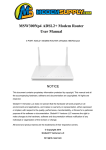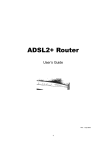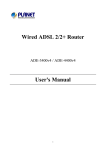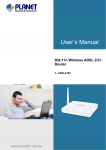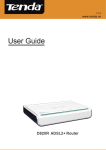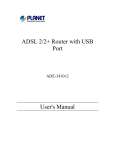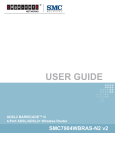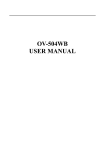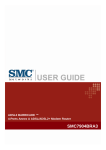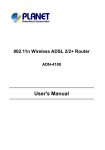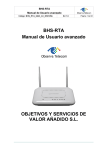Download 1 port ADSL2+ Router - User Manual
Transcript
1 Port ADSL2+Router User Manual i Contents 1. Introduction .................................................................................................................................................................. 1 1.1 Package List ........................................................................................................................................................ 1 1.2 Safety Cautions ................................................................................................................................................... 1 1.3 LED and Interface Description............................................................................................................................. 2 1.4 System Requirements .......................................................................................................................................... 3 1.5 Feature ................................................................................................................................................................ 3 1.6 FCC Compliance ................................................................................................................................................. 4 1.7 Supporting Protocols ........................................................................................................................................... 4 2. Hardware Installation .................................................................................................................................................... 5 3. Introducing Web Configuration ..................................................................................................................................... 7 3.1 How to access Router .......................................................................................................................................... 7 3.2 Status .................................................................................................................................................................. 8 3.2.1 System ...................................................................................................................................................... 8 3.2.2 LAN ......................................................................................................................................................... 9 3.2.3 WAN...................................................................................................................................................... 10 3.2.4 Statistic................................................................................................................................................... 10 3.2.4.1 Traffic Statistic..................................................................................................................................... 10 3.2.4.2 DSL Statistic........................................................................................................................................ 11 3.2.5 ARP Table .............................................................................................................................................. 12 3.3 Wizard .............................................................................................................................................................. 12 3.3.1 Wizard.................................................................................................................................................... 12 3.4 LAN.................................................................................................................................................................. 20 3.4.1 LAN Settings .......................................................................................................................................... 20 3.4.2 DHCP Settings........................................................................................................................................ 21 3.5 WAN ................................................................................................................................................................ 25 3.5.1 WAN Interface........................................................................................................................................ 26 3.5.2 ATM Settings ......................................................................................................................................... 28 3.5.3 ADSL Settings........................................................................................................................................ 29 3.6 Advance ............................................................................................................................................................ 30 3.6.1 DNS ....................................................................................................................................................... 30 3.6.1.1 DNS Server.......................................................................................................................................... 30 3.6.1.2 DDNS.................................................................................................................................................. 31 3.6.2 Firewall .................................................................................................................................................. 32 ii 3.6.2.1 IP\Port Filter ........................................................................................................................................ 32 3.6.2.2 MAC Filter .......................................................................................................................................... 33 3.6.2.3 URL Blocking...................................................................................................................................... 34 3.6.3 Virtual Server ......................................................................................................................................... 35 3.6.3.1 Services ............................................................................................................................................... 35 3.6.3.2 DMZ Settings....................................................................................................................................... 36 3.6.4 Routing................................................................................................................................................... 37 3.6.4.1 RIP ...................................................................................................................................................... 37 3.6.4.2 Static Route.......................................................................................................................................... 38 3.6.5 IP QoS .................................................................................................................................................... 39 3.6.6 Other ...................................................................................................................................................... 39 3.6.6.1 IGMP Proxy......................................................................................................................................... 40 3.6.6.2 UPNP................................................................................................................................................... 40 3.6.6.3 Bridge.................................................................................................................................................. 41 3.6.6.4 IP PassThrough .................................................................................................................................... 42 3.7 Admin ............................................................................................................................................................... 42 3.7.1 Remote Access........................................................................................................................................ 42 3.7.2 Commit/Reboot....................................................................................................................................... 43 3.7.3 Password................................................................................................................................................. 43 3.7.4 Backup/Restore....................................................................................................................................... 44 3.7.5 Upgrade Fireware.................................................................................................................................... 45 3.7.6 Time Zone .............................................................................................................................................. 45 3.7.7 SNMP..................................................................................................................................................... 46 3.7.8 TR069..................................................................................................................................................... 47 3.7.9 ACL ....................................................................................................................................................... 48 3.8 Diagnostic ......................................................................................................................................................... 49 3.8.1 Ping ........................................................................................................................................................ 49 3.8.2 ATM Loopback....................................................................................................................................... 50 3.8.3 ADSL ..................................................................................................................................................... 50 3.8.4 Diagnostic............................................................................................................................................... 51 APPENDIX B: Abbreviation ................................................................................................................................... 51 iii 1. Introduction The ADSL access device supports multiple line modes. It provides one 10/100Base-T Ethernet interface at the user end. Utilizing the high-speed ADSL connection, the device provide users with broadband connectivity to the Internet or the Intranet for high-end users as net bars, office users, etc. can provide a downlink speed up to 24 Mbit/s and uplink speed up to 1 Mbit/s. 1.1 Package List l One single port router l One external splitter l One power adapter l Two pieces of telephone lines(RJ-11,more than 1m) l One piece of Ethernet cable(RJ-45, more than 1.5m) l One copy of User’s Manual l A centificate of quality l One copy of driver and utility software CD(optional) 1.2 Safety Cautions Follow these announcements below to pretect the device from risks and damage caused by fire or electric power. 4 Use volume labels to mark the type of power. 4 Use the power adapter packed within the device package. 4 Pay attention to the power load of the outlet or prolonged lines. An overburden power outlet or damaged lines and plugs may cause electric shock or fire accident. Check the power cords regularly. If you find any damage, replace it at once. 4 Proper space left for heat radiation is necessary to avoid any damage caused by overheating to the device. The long and thin holes on the Access Point are designed for heat radiation to make sure the device works normally. Don’t cover these heat radiant holes. 4 Do not put this device close to a place where a heat source exits or high temperature occurs. Avoid the device from direct sunshine. 4 Do not put this device close to a place where is over damp or watery. Do not spill any fluid on this device. 4 Do not connect this device to any PC or electronic product, unless our customer engineer or your broadband provider instructs you to do this, because any wrong connection may cause any power or fire risk. 4 Do not place this device on an unstable surface or support. 1 1.3 LED and Interface Description Front panel Fig 1.3-1 Front panel LED POWER Color Green/Red Status Descriptions OFF No power GREEN Device init OK Device init Fireware upgrade RED RED BLINK Link Green ON Initial self-test failed Device is detecting itself Initial self-test of the unit is OK and ready OFF Internet connection failed BLINK Internet data transiting ON Internet connection OK OFF No LAN link BLINK LAN data transiting ON LAN link established and active OFF BLINK Data Ethernet Green Green Rear panel Fig 1.3-2 Rear panel Items DSL Usage Line RJ-11 port 2 Items Reset Ethernet PWR Usage Resets to factory defaults. To restore factory defaults, keep the device powered on and push a paper clip in to the hole. Press down the button over 5 seconds and then release. Ethernet RJ-45 port Power On/Off. Power connector. DC 10 Voltage/1000mA,female pole is positive. 1.4 System Requirements Make sure first that you have prepared these following items to guarantee the ROUTER can work normally. 4 Services subscriptions 4 An 10BaseT/100BaseT Ethernet card installed on your PC 4 HUB or Switch. (Attached to several PCs through one of Ethernet interfaces on the device) 4 Operation system: Windows 98SE, Windows 2000, Windows ME, or Windows XP 4 Internet Explorer V5.0 or higher, or Netscape V4.0 or higher, or firefox 1.5 or higher. 1.5 Feature 4 Supports various line modes 4 Supports external PPPoE dial-up access 4 Supports internal PPPoE/PPPoA dial-up access 4 Supports leased line mode 4 Supports ZIPB (Zero Installation PPP Bridge Mode) 4 Supports 1483B/1483R/MER access 4 Supports multiple PVCs(eight at most) and these PVCs can be isolated from each other 4 Support a single PVC with multiple sessions 4 Support multiple PVCs with multiple sessions 4 Supports the binding of the ports and the PVCs 4 Supports the 802.1Q and 802.1P protocol 4 Supports DHCP server 4 Supports NAT/NAPT 4 Supports static route 4 Supports firmware upgrade:WEB/tftp/ftp 4 Supports reset to factory default:reset, WEB 4 Supports DNS relay 4 Supports Virtual server 4 Supports DMZ functions 4 Supports two-grade passwords and usernames 4 Supports WEB interface 4 Supports telnet CLI 4 Supports System status display 3 4 Supports PPP session PAP/CHAP 4 Supports IP filter function 4 Supports remote access control 4 Supports line connection status test 4 Supports remote management(Telnet; HTTP) 4 Supports configuration file backup and restoration function 4 Ethernet supported such as Crossover Detection & Auto-Correction and polarity correction 4 Supports UPnP 1.6 FCC Compliance This equipment has been tested and found to comply with the limits for Class digital devices pursuant to part 15 of the FCC Rules. These limits are designed to provide reasonable protection against harmful interference when the equipment is operated in a commercial environment. This equipment generates, uses, and can radiate radio frequency energy and, if not installed and used in accordance with the instruction manual, may cause harmful interference to radio communication. Operation of this equipment in residential area is likely to cause harmful interference in which case the user will be required to correct the interference at this own expense. The user should not modify or change this equipment without written approval from company name. Modification could void authority to use this equipment. For the safety reason, people should not work in a situation which RF Exposure limits be exceeded. To prevent the situation happening, people who work with the antenna should be aware of the following rules: 1. Install the antenna in a location where a distance of 20cm from the antenna may be maintained. 2. While installing the antenna in the location, please do not turn on the power of wireless card. 3. While the device is working, please do not contact the antenna. 1.7 Supporting Protocols ITU G.992.1 (G.DMT) Annex A 4 ITU G.992.2 (G.LITE) 4 ANSI T1.413 Issue 2 4 ITU G.992.3 (ADSL2) 4 ITU G.992.5 (ADSL2+) 4 2. Hardware Installation 1、Refer to the figure below: Connect the DSL port of the device and the ROUTER port of the splitter with a telephone cable; connect the phone to the Phone port of the splitter through a cable; connect the incoming line to the Line port of the splitter. The splitter has three ports: LINE: Connects to a wall phone jack (RJ-11 jack) ROUTER: Connects to the DSL jack of the device PHONE: Connects to a telephone set 2、Connect the LAN port of the device to the network card of the PC via an Ethernet line (MDI/MDIX). Note: Use twisted-pair cables to connect with the HUB/Switch. 3、Plug the power adapter to the wall outlet and then connect the other end of it to the PWR port of the device. Connection 1: Fig. 2-1 displays the application diagram for the connection of the Router, PC, splitter and telephone set。 Fig 2-1 Connection Diagram(Without connecting telephone sets before the splitter) Connection 2:As illustrated in the following figure, the splitter is installed close to the device. 5 Fig 2-2 Connection Diagram(Connecting a telephone set before the splitter) l It is recommended to follow the Connection 1 in an actual connection! l Note: When Connection 2 is used, the filter must be installed close to the telephone lines. (See Fig. 2-2. Do not use the splitter instead of the filter). Installing a telephone directly before the splitter may lead to a failure of connection between the device and the device of LAN side, or cannot access into the Internet, or slow the connection speed if you really need to add a telephone set before the splitter, you have to add a MicroFilter before connecting to a telephone set. Do not connect several telephones before the splitter. Moreover, do not connect several telephones with MicroFilters. 6 3. Introducing Web Configuration 3.1 How to access Router The following introductions are prepared for the first time users, it is a detail “How-To” user guide. 1、 Open IE browser,then enter http://192.168.1.1 in address bar. 2、 You are required to enter user name and password. See the Fig 3.2-1. l The super user name and password is admin/admin l The common user name and password is user/user Fig 3.1-1 3、 If you enter as super user, the below screen will be displayed when you enter successfully. 7 Fig 3.1-2 After you enter router as super user, you can check, config and modify all the options. You can use the system diagnostic function also. If you enter as common user, you can check the status of ROUTER, but can’t change the most of options. 3.2 Status Click Status in the menu to open the sub-menu which contains 5 items: System, LAN, WAN, Statistic and ARP Table. 3.2.1 System Click System in the sub-menu to open the screen of Fig 3.2.1. In this page, you can view the current status and some basic settings of this router, for example, Software Version, DSL mode, Upstream Speed, Downstream Speed, Uptime and so on. 8 Fig 3.2.1 3.2.2 LAN Click LAN in the sub-menu to open the screen of Fig 3.2.2. In this page, you can view the LAN IP, DHCP Server status, MAC Address and DHCP Client Table. If you want to config the LAN network, refer to chapter 3.4.1 “LAN Settings”. Fig 3.2.2 9 3.2.3 WAN Click WAN in the sub-menu to open the screen of Fig 3.2.3. In this page, you can view basic status of WAN, Default Gateway, DNS Server, ect. . If you want to config the WAN network, refer to chapter 3.5.1 “WAN Interface”. Fig 3.2.3 3.2.4 Statistic Click Statistic in the sub-menu to open the menu in the left bar, whick contains two items:Traffic Statistic and DSL Statistic. 3.2.4.1 Traffic Statistic Click Traffic Statistic in the left bar to open the screen of Fig 3.2.4.1. In this page, you can view the statistics of each network port. 10 Fig 3.2.4.1 3.2.4.2 DSL Statistic Click DSL Statistic in the left bar to open the screen of Fig 3.2.4.2. In this page, you can view the ADSL line statistics, downstream rate, upstream rate, ect. . Fig 3.2.4.2 11 3.2.5 ARP Table Click ARP Table in the sub-menu to open the screen of Fig 3.2.5. In this page, you can view the talbe which shows a list of learned MAC addresses. Fig 3.2.5 3.3 Wizard Click Wizard in the menu to open the sub-menu which contains one item: Wizard. 3.3.1 Wizard Wizard enables speedy and accurate configuration of your Internet connection and other important parameters. The following sections describe these various configuration parameters. Whether you configure these parameters or use the default ones, click 'Next' to enable your Internet connection. When subscribing to a broadband service, you should be aware of the method by which you are connected to the Internet. Your physical WAN device can be either Ethernet, DSL, or both. Technical information regarding the properties of your Internet connection should be provided by your Internet Service Provider (ISP). For example, your ISP should inform you whether you are connected to the Internet using a static or dynamic IP address, or what protocols, such as PPPOA or PPPoE, you will be using to communicate over the Internet. Click Wizard in the sub-menu to open the screen of Fig 3.3.1-1. In this page, you can config the VPI/VCI number. 12 Fig 3.3.1-1 Be sure to use the correct Virtual Path Identifier(VPI) and Virtual Channel Identifier(VCI) numbers assigned to you. The valid range for VPI is 0 to 255 and for VCI is 1 to 65535. Then press Next, the Fig 3.3.1-2 screen will appear. In this page, you can select the WAN Connect Type and the encapsulation method. Fig 3.3.1-2 13 The following table describes the fields in this screen. Label Description WAN Connection Type Select the WAN Connection Type here, you can select PPPoA, PPPoE, 1483 MER, 1483 Routed or 1483 Bridged. Select the method of encapsulation used by your ISP from the drop-down list box. Choises are LLC/SNAP or VC-Mux. Click < Back to return to the previous screen Click Next > to go to the next screen Encapsulation Mode < Back Next > If you select PPPoA or PPPoE in WAN Connection Type, click Next, the screen of Fig 3.3.1-3 appears as shown next. Fig 3.3.1-3 The following table describes the fields of this screen. Label Description Obtain an IP address automatically Use the following IP address WAN IP Address Enable NAT The dynamic IP is not fixed; your ISP assigns you the different one each time. A static IP is a fixed IP that your ISP gives you. < Back Next > Input the IP address of the WAN interface provided by your ISP Select it to enable the NAT functions of the MODEM. If you are not to enable NAT and intend the user of the MODEM to access the Internet normally, you must add a route on the uplink equipment; otherwise the access to the Internet will fail. Normally, it is required to enable NAT. Click < Back to return to the previous screen Click Next > to go to the next screen Then click Next, the screen of Fig3.3.1-4 appears as shown next. 14 Fig 3.3.1-4 The following table describes the fields of this screen. Label Description PPP Username PPP Password PPP Connection Type < Back Next > The username and password apply to PPPoE and PPPoA encapsulation only. Make sure that you have entered the correct username and password. Choices are Continuous, Connect on Demand and Manual. Click < Back to return to the previous screen Click Next > to go to the next screen Then click Next, the screen of Fig3.3.1-5 appears as shown next. 15 Fig 3.3.1-5 The following table describes the fields of this screen. Label Description LAN IP Enter the IP address of your ROUTER in dotted decimal notation, for example, 192.168.1.1(factory default) Type the subnet mask of LAN IP. Select this check box to enable the secondary LAN IP Enter the secondary IP address of your ROUTER in dotted decimal notation, for example, 192.168.100.1(factory default) Type the subnet mask of the secondary LAN IP Select this check box to enable the DHCP Server This field specifies the first of the contiguous addresses in the IP address pool. This field specifies the last of the contiguous addresses in the IP address pool. Click < Back to return to the previous screen Click Next > to go to the next screen LAN Netmask Enable Secondary IP Secondary LAN IP Secondary LAN Netmask Enable DHCP Server Start IP End IP < Back Next > If you finish the settings of this page, click Next, the screen appears as shown next. 16 Fig 3.3.1-7 If you select 1483 MER in Fig 3.3.1-2, the screen appears as shown next. Fig 3.3.1-8 17 The following table describes the fields of this screen. Label Description Obtain an IP address automatically The MODEM will obtain a (WAN) IP address automatically and at this time it will enable DHCP Client functions. The WAN IP address is obtained from the uplink equipment like BAS and the uplink equipment is required to enable the DHCP Server functions. If you want to input the WAN ip address by yourself. Check this entry and then input related data in the field. Input the IP address of the WAN interface provided by your ISP Input the subnet mask concerned to the IP address of the WAN interface provided by your ISP. You can input the IP address of the default gateway by yourself, click this entry and then input related data in the fields. To obtain the IP address of the DNS server assigned by the uplink equipment such as BAS. If you want to input the IP address of the DNS server by yourself, click this entry and then input related data in the fields. Input the IP address of the primary DNS server here. Input the IP address of the secondary DNS server provided by your ISP here. Select it to enable the NAT functions of the MODEM. If you are not to enable NAT and intend the user of the MODEM to access the Internet normally, you must add a route on the uplink equipment; otherwise the access to the Internet will fail. Normally, it is required to enable NAT. Click < Back to return to the previous screen Click Next > to go to the next screen Use the following IP address WAN IP Address WAN Subnet Mask Default Gateway Obtain DNS server addresses automatically Use the following DNS server addresses Primary DNS server Secondary DNS server Enable NAT < Back Next > If you finish the settings of this page, click Next, the screen of Fig 3.3.1-6 appears. The settings of this screen, see above paragraphs. If you select 1483 Routed in Fig 3.3.1-2, the screen of Fig 3.3.1-9 appears as shown next. 18 Fig 3.3.1-9 The following table describes the fields of this screen. Label None Obtain an IP address automatically Use the following IP address WAN IP Address WAN Subnet Mask Obtain DNS server addresses automatically Use the following DNS server addresses Primary DNS server Secondary DNS server Enable NAT < Back Next > Description The dynamic IP is not fixed; your ISP assigns you the different one each time. A static IP is a fixed IP that your ISP gives you. Input the IP address of the WAN interface provided by your ISP Input the subnet mask concerned to the IP address of the WAN interface provided by your ISP. To obtain the IP address of the DNS server assigned by the uplink equipment such as BAS. If you want to input the IP address of the DNS server by yourself, click this entry and then input related data in the fields. Input the IP address of the primary DNS server here. Input the IP address of the secondary DNS server provided by your ISP here. Select it to enable the NAT functions of the MODEM. If you are not to enable NAT and intend the user of the MODEM to access the Internet normally, you must add a route on the uplink equipment; otherwise the access to the Internet will fail. Normally, it is required to enable NAT. Click < Back to return to the previous screen Click Next > to go to the next screen 19 3.4 LAN Click LAN in the menu to open the sub-menu which contains 2 items: LAN Settings and DHCP Settings. You can use the LAN configuration to define an IP address for the DSL Router and configure the DHCP server. 3.4.1 LAN Settings On this screen you can change the device's IP address. The preset IP address is 192.168.1.1. This is the Private IP address of the DSL Router. This is the address under which the device can be reached in the local network. It can be freely assigned from the block of available addresses. Click LAN Settings in the sub-menu to open the screen of Fig 3.4.1. In this page you can config the LAN network. Fig 3.4.1 The following table describes the fields of this screen. Label Description IP Address Subnet Mask Input the IP of Local area network interface here. We recommend that you use an address from a block that is reserved for private use. This address block is 192.168.1.1- 192.168.255.254 20 Secondary IP Apply Changes Select this checkbox to enable the secondary LAN IP. The two LAN IP must be in the different network. Click this button to save the settings of this page. 3.4.2 DHCP Settings DHCP(Dynamic Host Configuration Protocol) allows the individual client(computers) to obain the TCP/IP configuration at start-up from the centralize DHCP server. You can configure this router as a DHCP server or disable it. DHCP server can assign IP address, an IP default gateway and DNS server to DHCP clients. This router can also act as a surrogate DHCP server(DHCP Proxy) where it relays IP address assignment from a actual real DHCP server to clients. If the DHCP was disabled, the screen of Fig 3.4.2-1 appears. You can enable/disable DHCP Server or DHCP Proxy. Fig 3.4.2-1 If you set to DHCP Proxy, the screen of Fig 3.4.2-2 appears. 21 Fig 3.4.2-2 The following table describes the fields of this screen. Label Description DHCP Proxy If set to DHCP Proxy, your ROUTER acts a surrogate DHCP Server and relays the DHCP requests and reponses between the remote server and the client. Enter the IP address of the actual, remote DHCP server in this field. Click this button to save the changes of this page. DHCP Server Address Apply Changes If you set to DHCP Server, the screen of Fig3.4.2-3 appears as shown next. 22 Fig 3.4.2-3 The following table describes the fields in this screen. Label Description DHCP Server If set to DHCP Server, your ROUTER can assign IP addresses, an IP default gateway and DNS Servers to Windows95, Windows NT and other systems that support the DHCP client. This field specifies the first and the last of contiguous IP address of the IP address pool. Click this button, the screen of Fig 3.5.2-4 appears, which shows the assigned IP address of the clients. The Lease time determines the period for which the PCs retain the IP addresses assigned to them without changing them. Input the domain name here if you know. If you leave this blank, the domain name obtained by DHCP from the ISP is used. While you must enter host name(System Name) on each individual computer, the domain name can be assigned from this router via DHCP server. Enter the IP default gateway of the IP address pool. Click this button, the screen of Fig3.5.2-5 appears. This function allows you assign IP addresses on the LAN to specific individual computers based on their MAC address. IP Pool Range Show Client Max Lease Time Domain Name Gateway Address MAC-Base Assignment 23 Apply Changes Click this button to save the changes of this page. Click Show Client, the following window appears. In this window, you can view the IP address assigned to each DHCP client. Fig 3.4.2-4 The following table describes the fields in this screen. Label Description IP Address MAC Address This field displays the IP address relative to the MAC address. This field displays the MAC(Media Access Control) address of the computer. Every Ethernet device has a unique MAC address. The MAC address is assigned at the factory and consists of six pairs of hexadecimal character, for example, 00-A0-C5-00-02-12. Here shows the lease time. The Lease time determines the period for which the PCs retain the IP addresses assigned to them without changing them. Click this button to refresh the Active DHCP Client Table. Click this button to close this window. Time Expired(s) Refresh Close Click MAC-Base Assignment button, the below window appears. In this page, you can assign IP addresses on the LAN to specific individual computers based on their MAC address. 24 Fig 3.4.2-5 The following table describes the fields of this screen. Label Description Host MAC Address Assigned IP Address Assign IP Type the MAC address of a computer on your LAN This field specifics the IP of the IP address pool. Click this button after entered Host MAC Address and Assigned IP Address, a row will be added in MAC-Base Assignment Table. Select a row in MAC-Base Assignment Table, the MAC address and IP address will appears Host MAC Address and Assigned IP Address. After modified the MAC Address and IP Address, click this button to save the changes. Select a row in MAC-Base Assignment Table, then click this button, this row will be deleted. Click this button to close this window. This table shows the assigned IP address based on the MAC address. Modify Assigned IP Delete Assigned IP Close MAC-Base Assignment Table 3.5 WAN Click WAN Interface in the menu to open the sub-menu which contains 3 items: WAN Interface、ATM Settings and ADSL Settings. 25 3.5.1 WAN Interface Click WAN Interface in the sub-menu to open the screen of Fig 3.5.1-1. In this page, you can configure WAN Interface of your router. Fig 3.5.1-1 Label Description VPI (Virtual Path Identifier) The virtual path between two points in an ATM network, and its valid value is from 0 to 255 The virtual channel between two points in an ATM network, ranging from 32 to 65535 (1 to 31 are reserved for known protocols) Choices are LLC and VC-Mux. There are five choices: 1483 Bridged, 1483 MER, PPPoE, PPPoA and 1483 Routed. If select Disable, this PVC will be unusable. Select it to enable the NAPT functions of the MODEM. If you are not to enable NAPT and intend the user of the MODEM to access the Internet normally, you must add a route on the uplink equipment; otherwise the access to the Internet will fail. Normally, it is required to enable NAPT. VCI Encapsulation Channel Mode Admin Status Enable NAPT PPP Settings Login Name Password Connection Type The correct user name that your ISP has provided to you. The correct password that your ISP has provided to you The choices are Continuous, Connect on Demand and Manual. 26 Idle Time(min) WAN IP Settings Type Local IP Address Remote IP Address Subnet Mask Unnumbered Default Route Add Modify Delete Selected If select Connect on Demand, you need to input the idle timeout time. Within the preset minutes, if the MODEM doesn’t detect the flow of the user continuously, the MODEM will automatically disconnect the PPPOE connection. The choices are Fixed IP and Use DHCP. If set Fixed IP, you should enter the Local IP Address, Remote IP Address and Subnet Mask. If set Use DHCP, your MODEM will be a DHCP client, the WAN IP will be assigned by the remote DHCP server. This is the IP of WAN interface which is provided by your ISP. This is the gateway IP which is provided by your ISP. This is the Subnet Mask of the Local IP Address. Select this checkbox to enable IP Unnumbered function. After configuring the parameters of this page, click this button then a new PVC will be added into Current ATM VC Table. Select a PVC in the Current ATM VC Table, then modify the parameters of this PVC. When you finish, click this button to apply the change of this PVC. Select a PVC in the Current ATM VC Table, then click this button to delete this PVC. Click this button, the following screens will appear. In these pages, you can modify the PVCs’ parameters. If the PVC uses PPPoE mode, click , the Fig 3.5.1-2 will appear. In this page, you can configure this PPPoE PVC’s parameters. 27 Fig 3.5.1-2 3.5.2 ATM Settings Click ATM Setting, the screen of Fig 3.5.1-3 will appear. In this page, you can configure the parameters of the ATM for your ADSL router, include QoS type, PCR, CDVT, SCR and MBS. 28 Fig 3.5.1-3 3.5.3 ADSL Settings Click ADSL Interface in the sub-menu to open the screen of Fig 3.5.2. In this page, you can select the DSL modulation. Mostly, the user just need to remain this factory default setting. Our modem support these modulations: G.Dmt, G.lite, T1.413, ADSL2, ADSL2+, AnnexL and AnnexM. The router will negotiate the modulation mode with the DSLAM. 29 Fig 3.5.2 3.6 Advance Click Advance in the menu to open the sub-menu which contains 6 items: DNS, Firewall, Virtual Server, Routing, IP QOS, and Others. 3.6.1 DNS Click DNS in the sub-menu to open the menu in the left bar, whick contains two items:DNS Server and DDNS. 3.6.1.1 DNS Server Short for Domain Name System (or Service or Server), an Internet service that translates domain names into IP addresses. Because domain names are alphabetic, they're easier to remember. The Internet however, is really based on IP addresses. Every time you use a domain name, therefore, a DNS service must translate the name into the corresponding IP address. For example, the domain name www.example.com might translate to 198.105.232.4. The DNS system is, in fact, its own network. If one DNS server doesn't know how to translate a particular domain name, it asks another one, and so on, until the correct IP address is returned. 30 Click DNS Server in the left bar to open the screen of Fig 3.6.1.1. Fig 3.6.1.1 Label Description Attain DNS Automatically When this checkbox is selected, this router will accept the first received DNS assignment from one of the PPPoA, PPPoE or MER enabled PVC(s) during the connection establishment. When this checkbox is selected, please enter the primary and optional secondary DNS server IP addresses. Click this button to save the settings of this page. Click this button to begin configuring this screen afresh. Set DNS Manually Apply Changes Reset Selected 3.6.1.2 DDNS Click DDNS in the left pane to open the screen of Fig 3.6.1.2. 31 Fig 3.6.1.2 3.6.2 Firewall Click Firewall in the sub-menu to open the menu in the left bar, whick contains three items:IP\Port Fileter, MAC Filter and URL Blocking. 3.6.2.1 IP\Port Filter Click IP\Port Filter in the left bar to open the screen of Fig 3.6.2.1. Entries in this table are used to restrict certain types of data packets through the Gateway. Use of such filters can be helpful in securing or restricting your local network. Click the button Apply Changes to save the settings of this page. Click the button Add to add a new rule of the IP\Port Filter. 32 Fig 3.6.2.1 3.6.2.2 MAC Filter Click MAC Filter in the left bar to open the screen of Fig 3.6.2.2. Entries in this table are used to restrict certain types of data packets from your local network to Internet through the Gateway. Use of such filters can be helpful in securing or restricting your local network. Click the button Apply Changes to save the settings of this page. Click the button Add to add a new rule of the MAC Filter. 33 Fig 3.6.2.2 3.6.2.3 URL Blocking Click URL Blocking in the left bar to open the screen of Fig 3.6.2.3. This page is used to configure the Blocked FQDN(Such as tw.yahoo.com) and filtered keyword. Here you can add/delete FQDN and filtered keyword. 34 Fig 3.6.2.3 3.6.3 Virtual Server Click Virtual Server in the sub-menu to open the menu in the left bar,whick contains two items:Services and DMZ Settings. 3.6.3.1 Services Click Services in the left pane to open the screen of Fig 3.6.3.1. This page is used to enable the servers in the local network. Click the button Add to add a virtual server. 35 Fig 3.6.3.1 3.6.3.2 DMZ Settings Click DMZ Settings in the left bar to open the screen of Fig 3.6.3.2. A Demilitarized Zone is used to provide Internet services without sacrificing unauthorized access to its local private network. Typically, the DMZ host contains devices accessible to Internet traffic, such as Web (HTTP ) servers, FTP servers, SMTP (e-mail) servers and DNS servers. Select the checkbox Enable DMZ to enable this function. Then input a IP Address of the DMZ host. Click the button Apply Changes to save the settings of this page. 36 Fig 3.6.3.2 3.6.4 Routing Click Routing in the sub-menu to open the menu in the left bar, whick contains two items:RIP and Static Route. 3.6.4.1 RIP Click RIP in the left bar to open the screen of Fig 3.6.4.1. Enable the RIP if you are using this device as a RIP-enabled router to communicate with others using the Routing Information Protocol. This page is used to select the interfaces on your deviceis that use RIP, and the version of the protocol used. 37 Fig 3.6.4.1 3.6.4.2 Static Route Click Static Route in the left bar to open the screen of Fig 3.6.4.2-1. This page is used to configure the routing information. Here you can add/delete IP routes. Fig 3.6.4.2-1 Click the button Show Routes, the below window will appear. The table shows a list of destination routes commonly accessed by your network. Fig 3.6.4.2-2 38 3.6.5 IP QoS Click IP QoS in the sub-menu to open the screen of Fig 3.6.5. Entries in this table are used to assign the precedence for each incoming packet based on physical LAN port, TCP/UDP port number, and source/destination IP address/subnet masks. Click the button Apply Changes to save the settings of this page. Fig 3.6.5 3.6.6 Other Click Others in the sub-menu to open the menu in the left bar,whick contains four items:IGMP Proxy, UPNP, Bridge and IP PassThrough. 39 3.6.6.1 IGMP Proxy Click IGMP Proxy in the left bar to open the screen of Fig 3.6.6.1. IGMP proxy enables the system to issue IGMP host messages on behalf of hosts that the system discovered through standard IGMP interfaces. The system acts as a proxy for its hosts after you enable it. Click Apply Changes to save the settings of this page. Fig 3.6.6.1 3.6.6.2 UPNP Click UPNP in the left bar to open the screen of Fig 3.6.6.2. This page is used to configure UPnP. The system acts as a daemon after you enable it. Click Apply Changes to save the settings of this page. 40 Fig 3.6.6.2 3.6.6.3 Bridge Click Bridge in the left bar to open the screen of Fig 3.6.6.3-1. This page is used to configure the bridge parameters. Here you can change the settings or view some information on the bridge and its attached ports. Fig 3.6.6.3-1 Click Show MACs button in Fig 3.6.6.3-1, the below window will appear. This table shows a list of learned MAC addresses for this bridge. Fig 3.6.6.3-2 41 3.6.6.4 IP PassThrough Click IP PassThrough in the left bar to open the screen of Fig 3.6.6.4. The IP PassThrough has the other name ZIPB or IP Extension. In this page, you can enable and configure IP PassThrough function. Fig 3.6.6.4 3.7 Admin Click Admin in the menu to open the sub-menu which contains 9 items: Remote Access, Commit/Reboot, Password, Backup/Restore, Upgrade Fireware, Time Zone, SNMP ,TR069 and ACL. 3.7.1 Remote Access Click Remote Access in the sub-menu to open the screen of Fig 3.7.1. In this page, you can enable or disable the services which will be used by remote host. For example, if TELNET service is enabled and port is 23, the remote host can access this router by telnet through port 23. 42 Fig 3.7.1 3.7.2 Commit/Reboot Click Commit/Reboot in the sub-menu to open the screen of Fig 3.7.2. In this page, you can set the router reboot to default settings or set the router save the current settings then reboot. Fig 3.7.2 Label Description Restore to Factory Default Setting Save Current Setting System Reboot Select this checkbox to reset router to default settings. Select this checkbox to save the current settings and reboot router. Click this button to reboot the router according to the above option. 3.7.3 Password Click Password in the sub-menu to open the screen of Fig 3.7.3. In this page, you can change the password of the user, include admin and user. The super user name and password are admin/admin as default, and the The common user name and password are user/user. 43 Fig 3.7.3 Label Description User Name Select the user name in the drop-down list box. The choices are admin and user. After selected the user name, input the old password of the user here. Input the new password what you want to set of the user. Input the new password again. Click this button to save the settings of this page. Click this button to begin configuring the password afresh. Old Password New Password Confirmed Password Apply Changes Reset 3.7.4 Backup/Restore Click Backup/Restore in the sub-menu to open the screen of Fig 3.7.4. In this page, you can backup the current settings to a file and restore the settings from the file which was saved previously. IMPORTANT! Do not turn off your router or press the Reset button while these procedures are in progress. Fig 3.7.4 44 Label Description Save Settings to File Click the Save button, then select the path and save the configuration file of your router. Click the Browse button to select the configuration file. Selected the configuration file of router, click Upload button to begin restore the router configuration. Load Settings from File Upload 3.7.5 Upgrade Fireware Click Upgrade Fireware in the sub-menu to open the screen of Fig 3.7.5. In this page, you can upgrade the fireware of this router. IMPORTANT! Do not turn off your router or press the Reset button while this procedure is in progress. Fig 3.7.5 Label Description Select File Upload Click the Browse button to select the Fireware file. Selected the Fireware file, click Upload button to begin upgrading the Fireware. Click this button to begin selecting the Fireware file afresh. Reset 3.7.6 Time Zone Click Time Zone in the sub-menu to open the screen of Fig 3.7.6. In this page, you can set the system time manually or get the system time from the time server. 45 Fig 3.7.6 Label Description Refresh Time Mode Click this button to refresh the system shown in the page. If select Time Server, the router will get the system time from the time server. If select Manual, you should configure the system time manually. If select this checkbox, you can choose the correct SNTP Server which you want. Choose the SNTP Server here. Select the Time Zone of in which area you are. Click this button to save the settings of this page. Enable SNTP Client Update SNTP Server Time Zone Apply Changes 3.7.7 SNMP Click SNMP in the sub-menu to open the screen of Fig 3.7.7. In this page, you can set the SNMP parameters. 46 Fig 3.7.7 Label Description Trap IP Address Input the Trap Host’s IP here. The trap information will be sent to this host. The network administrators must use this password to read the information of this router. The network administrators must use this password to configure the information of this router. Click this button to save the settings of this page. Click this button to begin configuring this screen afresh. Community name(read-only) Community name(write-only) Apply Changes Reset 3.7.8 TR069 Click TR069 in the sub-menu to open the screen of Fig 3.7.8. In this page, you can configure the TR-069 CPE. 47 Fig 3.7.8 3.7.9 ACL Click ACL in the sub-menu to open the screen of Fig 3.7.9. In this page, you can configure the IP Address for Access Control List. If ACL enabled, only the effective IP in ACL can access ADSL Router. Step 1: If you want to enable ACL, please choose "Enable" then press "Apply Changes"; Step 2: Config Access Control List; Note: If you check "Enable" in ACL Capability, please make sure that your host IP is in ACL List before it takes effect 48 Fig 3.7.9 3.8 Diagnostic Click Diagnostic in the menu to open the sub-menu which contains 4 items: Ping, ATM Loopback, ADSL and Diagnostic. 3.8.1 Ping Click Ping in the sub-menu to open the screen of Fig 3.8.1. Fig 3.8.1 Label Description Host Address Go! Enter the IP Address here. Click this button to begin to Ping the Host Address. 49 3.8.2 ATM Loopback Click ATM Loopback in the sub-menu to open the screen of Fig 3.8.2. In this page, you can use VCC loopback function to check the connectivity of the VCC. Fig 3.8.2 Go!:Click this button to begin testing. 3.8.3 ADSL Click ADSL in the sub-menu to open the screen of Fig 3.8.3. This page is used for ADSL Tone Diagnostics. Fig 3.8.3 50 Start:Click this button to begin ADSL Tone Diagnostics. 3.8.4 Diagnostic Click Diagnostic in the sub-menu to open the screen of Fig 3.8.4. This page is used for testing your DSL connection. Fig 3.8.4 Run Diagnostic Test:Click this button to begin testing. APPENDIX A: Abbreviation ADSL Asymmetric Digital Subscriber Line ATM Asynchronous Transfer Mode ATU C ATU at the central office end (i.e., network operator) ATU R ATU at the remote terminal end (i.e., CP) BER Bit Error Ratio CO Central office CPE Customer Premises Equipment CRC Cyclic Redundancy Check DC Direct Current DSL Digital Subscriber Line HEC Header Error Control IDFT Inverse Discrete Fourier Transform LOF Loss-of-frame defect LOS Loss-of-signal defect MIB Management Information Base 51 Modem (MOdulator, DEModulator) NMS Network Management System OAM Operations, Administration and Maintenance POTS Plain old telephone service; one of the services using the voiceband; sometimes used as a descriptor for all voiceband services PSTN PVC Public Switched Telephone Network Persist Virtual Circuit QAM Quadrature Amplitude Modulation SNR Signal to Noise Ratio TP Twisted Pair VPN Virtual Private Network 52























































